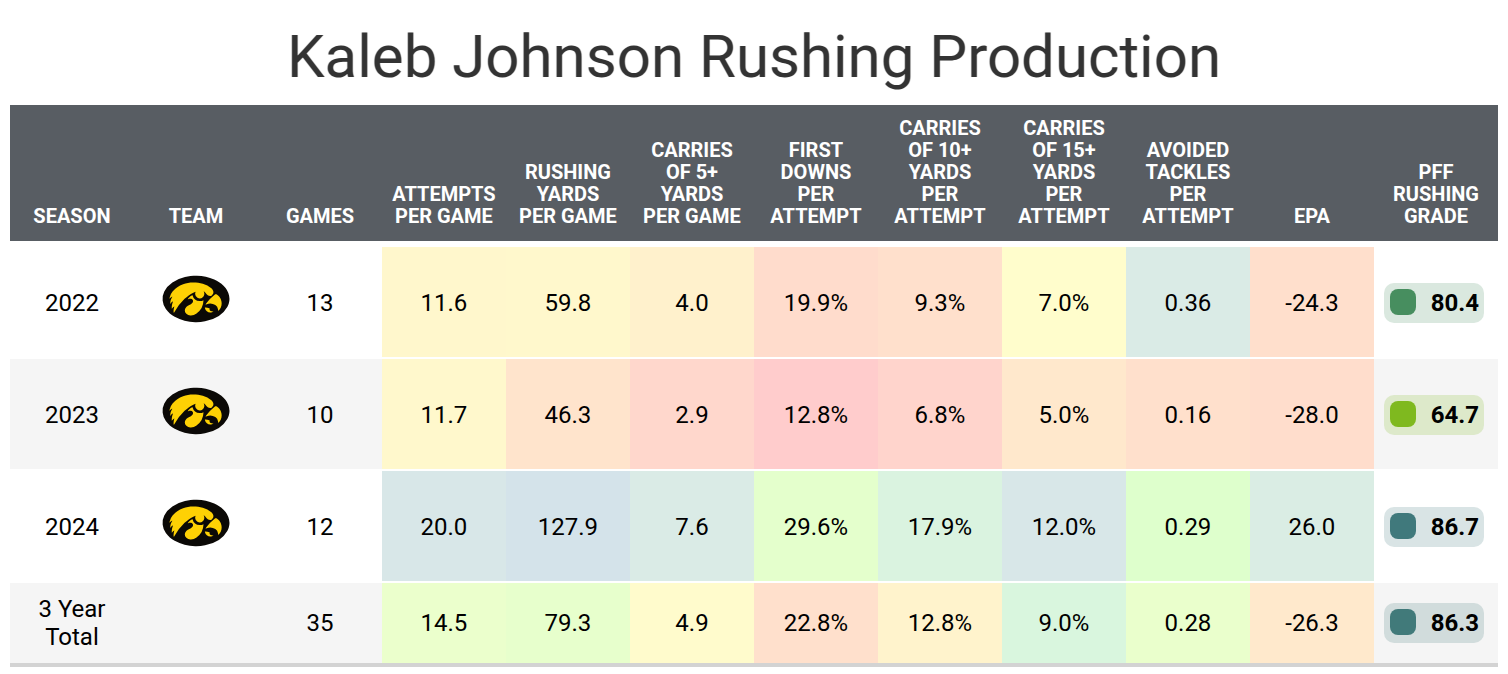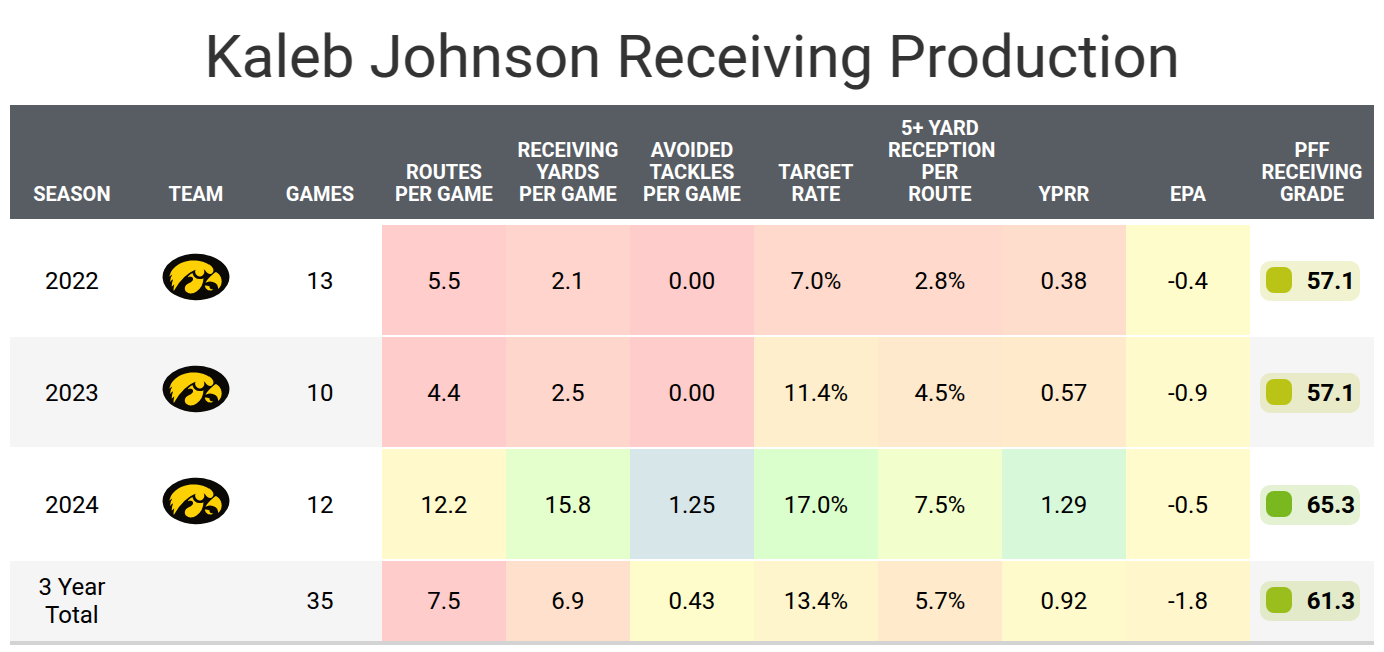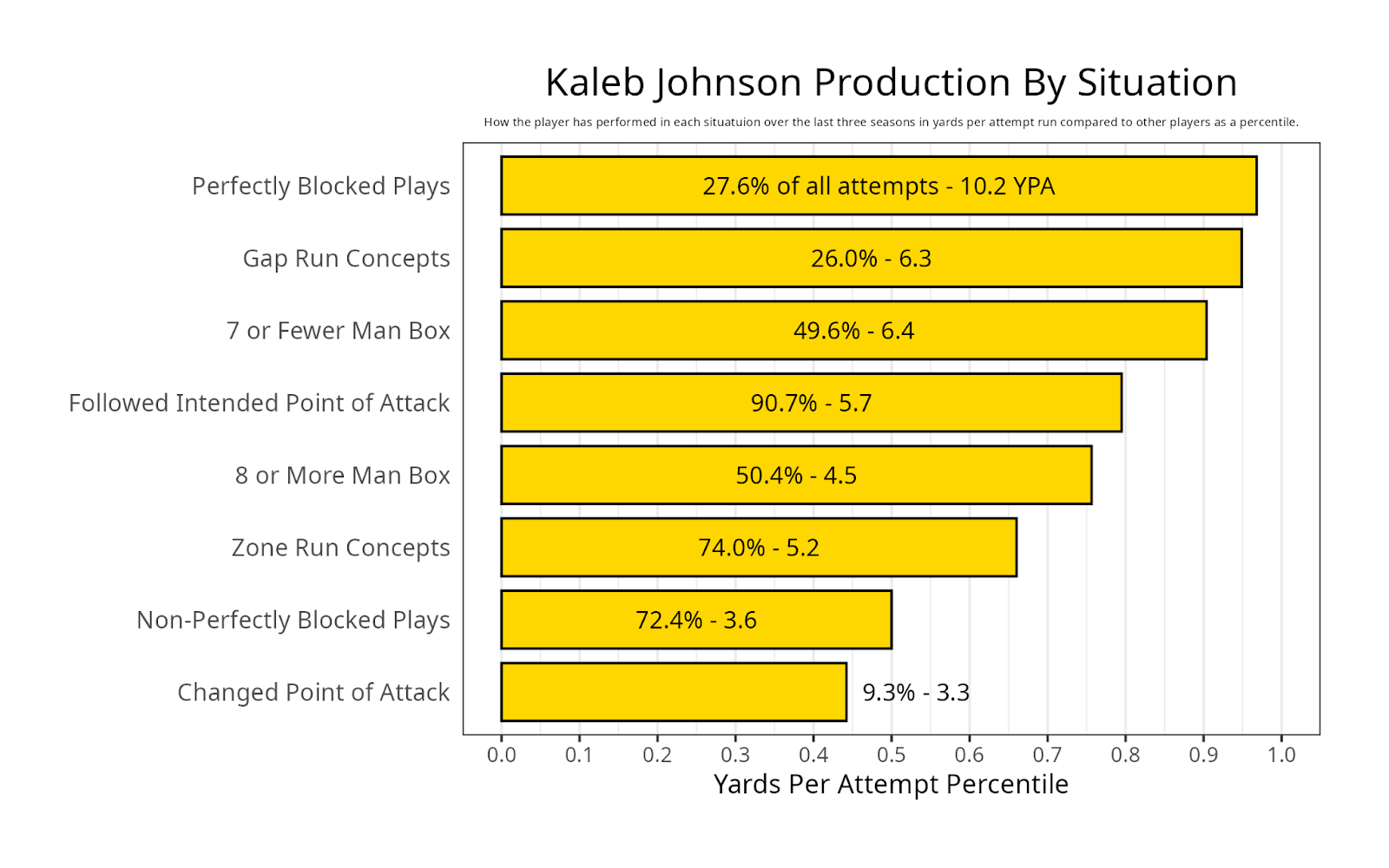- Kaleb Johnson took advantage of his opportunity: Johnson wasn’t the Iowa Hawkeyes‘ starter until his final season, but he dominated in the run game once he had the chance.
- Johnson lacks experience as a receiver: While Johnson was typically on the field in passing situations, he averaged less than seven receiving yards per game during his college career.
- 2025 NFL Draft season is here: Try PFF's best-in-class Mock Draft Simulator and learn about 2025's top prospects while trading and drafting for your favorite NFL team.
Estimated Reading Time: 5 minutes

PFF’s fantasy football player profile series delivers the most in-depth fantasy football analysis available for the 2025 season.
Using PFF’s exclusive data, we evaluate player performance, competition for touches and how teammates and coaching staffs will impact each player's fantasy football outlook.
Last updated: 7:15 a.m. Wednesday, April 9
Click here for more draft tools:
NFL Draft Big Board | Mock Draft Simulator | NCAA Premium Stats
2025 PFF Draft Guide | Mock Draft Hub | Prospect Data Profiles
Draft Position Rankings
Player Performance
Johnson was a backup to Leshon Williams during his first two seasons at Iowa, playing predominantly in short-yardage situations. Johnson’s numbers weren’t all that impressive in 2023, but he earned the starting job over Williams by the start of the 2024 season. Williams entered the transfer portal after the first three weeks of the season, allowing Johnson to take an even higher percentage of the offensive snaps.
Johnson was very impressive as a runner in his one season as a starter, averaging over 125 rushing yards per game. His rate of hitting big runs was among the best in the league. He ranks among the top 25 fastest running backs in the FBS from the last eight seasons, according to PFF tracking data, despite a below-average 4.57-second 40-yard dash at the combine. Johnson had the highest rate of zone plays among those running backs, but his quality of play in both zone and gap concepts was relatively similar. Johnson depended more on ideal situations than most running backs, dominating more than nearly every other running back on perfectly blocked plays. Still, he was only average compared to FBS backs on non-perfectly blocked plays.
While Johnson posts a respectable 86.3 career rushing grade, that is the lowest among the top 11 rookie running backs by consensus rankings. That was mainly due to his relatively average grades throughout 2023. He also has the least experience as a receiver, with just 36 total targets. He gained 63 receiving yards in his final collegiate game against Nebraska but was held to 10 receiving yards or fewer in nine of his 12 games.



Projected Role
Johnson only projects to be a two-down back in the NFL. Along with his lack of experience catching passes, he struggled as a pass protector. Johnson is athletically gifted enough to become a three-down back at some point in his career, but it’s unlikely to happen as a rookie.
A situation to monitor will be his third-down role. He was Iowa’s clear third down back in his final season, and that can generally be a situation to catch some easy passes. For example, Zach Charbonnet was the Seattle Seahawks’ third-down back last season, but Kenneth Walker III received more snaps during two-minute drills than Charbonnet. This led to 15 of Walker’s 46 receptions for 92 yards. For Johnson, those two-minute drill snaps could be the difference between a top-24 fantasy running back or someone outside the top 24.
Johnson has the talent to be an early down back for a team, but there is also no guarantee he will see that role as a rookie. Trey Benson and Blake Corum seemed like running backs who could be starters in last year’s draft, but they landed on teams with James Conner and Kyren Williams. It’s possible that Johnson also lands on a team with an established veteran as a starter.

Most Mocked Teams
Dallas Cowboys
Johnson is typically a second-round pick in mock drafts and occasionally falls to the third round. The Cowboys added Javonte Williams and Miles Sanders in free agency, but Johnson could quickly earn the early down role in Dallas while Williams takes the third-down responsibilities.
Chicago Bears
Chicago is the best-case scenario for any rookie running back. Johnson could become the early-down back for Chicago, while D’Andre Swift or someone else plays in passing situations. The offensive line could help Johnson to a top-15 finish in this offense.
Cleveland Browns
The Browns are another team where Johnson could be a Week 1 starter. Jerome Ford is currently penciled into the starting role, but Ford could be relegated to third-down duties with Johnson on the roster.
Bottom Line
Johnson might only be an early-down back in the NFL, which would limit his upside, but there are plenty of examples of two-down backs who consistently finish as a fantasy starter.
Footnotes
- Statistics in tables and charts were generally chosen based on their ability to predict future fantasy performance on a per-game or per-opportunity basis or for their ability to describe the player relative to others at the same position.
- “Opportunities” are defined as passing dropbacks, rushing attempts and receiving routes run.
- Numbers are either by season or based on the past three years. For rookies, only college numbers are included. Only NFL numbers are included for non-rookies, even if they played in college during the previous three years.
- Because college competition is easier than NFL competition, most rookies will likely see a decline from their historic numbers.
- Only FBS data is considered for college players and comparisons.
- Kneel-downs are removed from rushing data to provide cleaner quarterback rushing rate statistics.
- The colors for all tables in this article range from blue (good or high) to red (bad or low).
- All percentiles or colors compare the given player to other players with a high sample of opportunities. Generally, the cut-off is one-third of the possible opportunities in the sample. If the player in question doesn’t have enough opportunities, they are still compared, even though they could look good or bad based on the small sample size, which might not be as predictive.
- Information on utilization classifications and their importance can be found here for running backs, wide receivers and tight ends.



 © 2025 PFF - all rights reserved.
© 2025 PFF - all rights reserved.